Flex Innovations FlexJet Super PNP
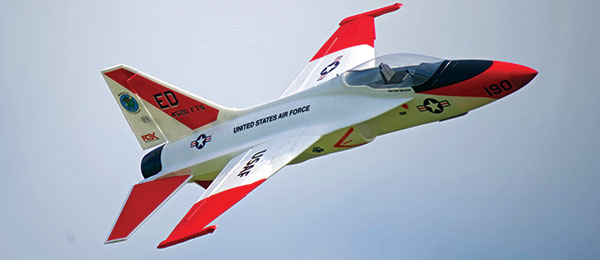
Written by Jon Barnes A fast and nimble EDF jet experience Product review As seen in the September 2018 issue of Model Aviation.
Review video
Specifications
Model type: EDF jet Skill level: Advanced Wingspan: 41.6 inches Wing area: 420 square inches Length: 55.1 inches Weight: 6.7 pounds Power system: 90 mm EDF Battery: Minimum 40C 6S 22.2-volt 4,000 to 5,200 mAh Radio: Minimum six-channel required Construction: EPO foam Price: $529.99Test-Model Details
EDF: 90 mm with 11-blade impeller Motor: Potenza 60BLDF 1,450 Kv brushless outrunner ESC: HobbyWing SkyWalker 80-amp brushless with external 8-amp BEC; EC3 connector Battery: Turnigy heavy-duty 60C 6S 22.2-volt 5,000 mAh LiPo Radio system: Spektrum DX9 DSMX transmitter; Spektrum AR610T receiver with SRXL Ready-to-fly weight:6 pounds, 14.5 ounces Flight duration: 4 to 6 minutesPluses
• 4- to 6-minute flight durations, which is substantially longer than many 90 mm EDF jets. • Sleek, streamlined airframe retains energy. • Aura 8 flight stabilization enhances in-flight tracking, especially when flying on windy days. • Large battery compartment will accept a variety of pack sizes and capacities. • Suspension-equipped landing gear and a full set of sequenced gear doors.Minuses
• No pilot figure included with the kit. • Pilots with larger hands might have a hard time working inside the exhaust ducting.Product review
For pilots who are passionate about aerobatic and 3D-capable models, Flex Innovations is a veritable candy shop. Since its founding in 2013 by Quique Somenzini and David Ribbe—both well known within the industry and competitive circles—the company has staked out a solid claim with its impressive array of aerobatic and extreme 3D models. Heading into 2018, the Flex Innovations product lineup reflected Quique’s influence and passion, known worldwide for his genre-defining 3D piloting skills. However, people would be remiss to forget David’s similarly impressive abilities, résumé, and skillset. A veteran of a variety of industry competition events such as the Jet World Masters, the U.S. Scale Masters, and Top Gun, David knows and loves jets! With a full mantle’s worth of jet event trophies to David’s credit, including several Mr. Top Gun titles, it was only a matter of time before Flex Innovations would turn its attention to EDF-powered jets! The first (of hopefully many) EDF jet to be released is the company’s 90 mm EDF-powered, EPO foam-composition model, christened the FlexJet.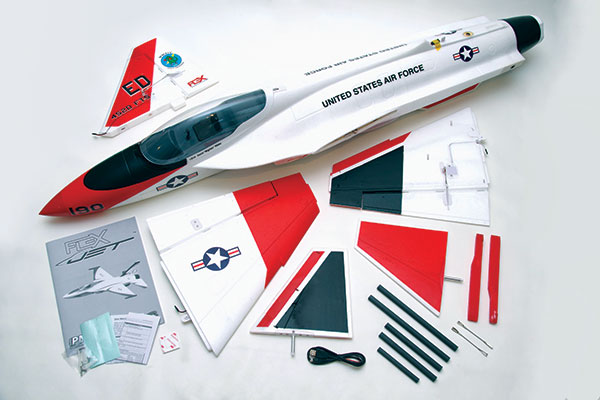
Labeled as a “Super Plug and Play” kit, the EPO foam kit includes a full complement of preinstalled, high-quality Potenza digital servos and the advanced Aura flight-stabilization module.
To many pilots, 90 mm EDF-powered sport jets represent the pinnacle of potential performance that can be wrung out of an electric jet (although there are 105 mm EDF-powered jet models, the scant number of models available is testimony to their limited popularity and market share). Sport jets are typically free from the design constraints inherent to scale jet models. While the latter demands that diligent attention be paid to maintaining a scalelike profile, the former allows designers to focus solely on achieving maximum airframe and power-system performance and efficiency. Sport jets are not typically modeled after any real-world counterparts, allowing designers to take nearly unlimited liberties in their quest to create the ultimate EDF jet. Although the FlexJet is, at heart, a sport jet, astute full-scale jet aircraft enthusiasts will nonetheless notice its undeniable similarity to the Korean Airspace Industries T-50 supersonic advanced trainer. An additional relevant fact is that the T-50 design was largely based on the Lockheed Martin F-16 Fighting Falcon. Specifically, the FlexJet’s large vertical stabilizer, anhedral-equipped, full-flying stabilizers, and leading edge root extensions resemble those used on the T-50 and F-16 airframes. Notable design features that hint at this model’s thoroughbred pedigree include full inlet and exhaust ducting with no apparent need for auxiliary air intakes, a full set of sequenced gear doors, suspension-equipped aluminum trailing link struts, and metal control rods and ball-link connections for all control surfaces. As do most of the offerings from Flex Innovations, the FlexJet comes with a preprogrammed Aura 8 advanced-flight control and stabilization system. A full complement of digital servos and a lush-sounding, 11-blade, 90 mm EDF power system also come preinstalled. Pilots can choose between an orange or blue color scheme, although the colors might actually appear to be more red or purplish blue. Flex Innovations provides no pilot figure or cockpit graphics with the FlexJet, although a control stick and removable seat simplify the task of sourcing and installing a pilot bust for those who prefer one. The airframe is also devoid of flaps.

This 90 mm sport jet is available in either an orange or blue color scheme. All graphics are preapplied at the factory.
Assembly
The bulk of the assembly of this model involves attaching the two full-flying stabilizers and their control linkages. For most models, the elevator servos and control linkages are located within easy reach on the outside of the airframe. The Flex Innovations design wisely secretes them internally. Although this design decision effectively streamlines the airframe and minimizes potential airflow-disturbing, velocity-robbing protrusions, it comes with a caveat that can be particularly critical for pilots with larger hands. Access to the elevator servos is made by removing the thrust tube and inserting ones hands inside the exhaust duct. Pilots will need to mount the two flying stabilizers to the elevator servo shafts then secure them in place using the included Allen-head fasteners. Flex Innovations includes a stubby, L-shaped hex wrench in the box. This part of the assembly also requires that pilots cut out and use the included elevator neutral-position templates, located toward the rear of the assembly manual.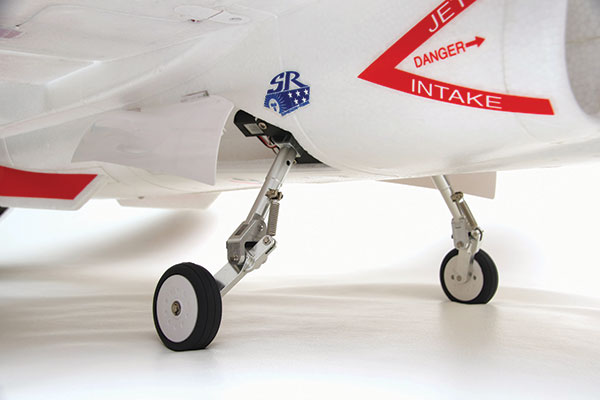
The impressively engineered, suspension-equipped, aluminum landing gear potentially allows the FlexJet to be operated from less-improved, unpaved airstrips, but the smallish diameter of the tires/wheels could be a limiting factor.
The neutral positions are adjusted by rotating the metal clevises, which effectively lengthen or shorten the metal pushrods. Pilots with larger hands can avoid aggravation by simply seeking out the assistance of a smaller-proportioned person. Additionally, a comprehensive video that covers this process is available. The balance of the airframe assembles quickly using fasteners, although pilots will need to attach the missile rails and rear fuselage exhaust fairings using their choice of adhesive. This model’s Aura 8 advanced-flight control system effectively negates the bulk of the normal transmitter programming workflow that pilots are accustomed to performing. The Aura 8 comes with three preprogrammed flight modes; pilots only need to configure a flight mode switch on their receivers in order to select them. The rates and exponentials are preset at the factory. Advanced pilots have the option of connecting to and amending the factory settings by using the included USB cable and Windows-based Aura Config application. The free software is available on the Flex Innovations website. Although nearly any brand of traditional pulse-width modulation, six-channel receiver can be used, the high-speed digital communication capabilities of Flex’s Aura 8 system encourages modelers to use a Spektrum SRXL, Futaba or Hitec S. Bus, Graupner HOTT, JR XBus, or Jeti UDI-12 receiver. Pilots can also opt to use a pair of Spektrum DSMX satellites, which can be plugged directly into the Aura 8 controller. Flex does recommend that pilots plug the ESC throttle lead directly into a receiver’s throttle port instead of the Aura 8, if it is so equipped. This allows the throttle to respond directly to a receiver’s programmed failsafe settings.
Flying
The FlexJet’s battery bay features ample space. Pilots should be able to fit packs of a variety of sizes and dimensions within the large foam airframe and still be able to achieve the recommended center of gravity. I was able to fit a hefty FlightPower 6S 5,500 mAh battery pack in place with no problems. The model comes with an EC3-style connector attached to the ESC, which includes an external 8-amp BEC. Bearing in mind that fliers should have a specific goal for every flight made, a pilot’s first FlexJet flight should primarily focus on trimming out the airframe and performing an auto-trim procedure on the Aura 8 upon landing. Details regarding this procedure can be found in the manual. Another preflight consideration that is unique to this model is the need to cycle the landing gear each time the model is powered up. The FlexJet includes a standalone electronic gear sequencer that is used to control and coordinate the operation of the electric retractable gear and servo-operated full gear doors. Cycling the gear allows the gear and door to synchronize. Quickly toggling the landing gear switch is all that is required. The only downside to forgetting to perform this step on the ramp is that a pilot will have to cycle the gear switch twice in flight in order to get the landing gear to properly retract. Most pilots would be thrilled to have Quique or David on a buddy box on their new 90 mm FlexJet’s maiden flight! With the Aura 8 onboard and online, that is, in many ways, exactly what pilots have backing them up.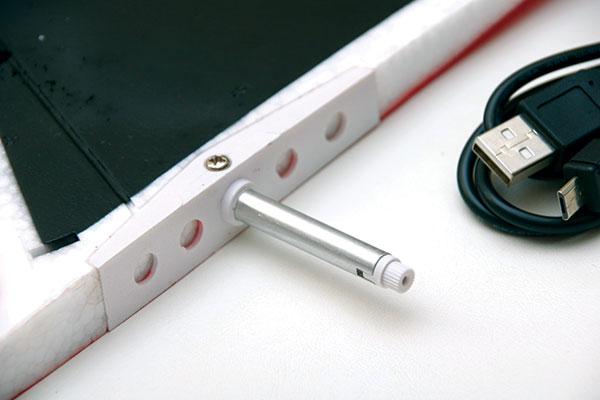
Installing the full-flying stabilizers, which requires slipping one’s hand into the end of the model, might be challenging for those with bigger mitts.
As a part of its development, David and Quique exhaustively flew and tested the airframe and came up with the best control throws, gyro settings, etc. Their findings and research are embedded in the three flight modes that are preprogrammed into the Aura 8. A bonus is even included in the form of a fourth mode that can be unlocked by pilots who want to push the FlexJet to the extreme. The first two modes are identical when it comes to the net amount of control surface deflections. The sole difference is that the flight stabilization feature is disabled in the first flight mode and enabled in the second. The third flight mode features active flight stabilization but with substantially increased control throws. Pilots will likely favor making their first flights in flight mode two (low rates, gyro on). The FlexJet responds in a benign manner in this mode, making it perfect for becoming accustomed to the model’s in-flight behavior. The flight stabilization feature does a great job of mitigating the effects of wind and dirty air, without ever feeling as though it is getting in the way of the pilot’s control inputs. Switching to the third flight mode (high rates, gyro on) substantially cranks up the control throws and allows pilots to push the FlexJet through more extreme high-G maneuvers. This jet excels at knife-edge flight, thanks to the preprogrammed mix contained in the Aura 8. Maneuvers that are within this EDF jet’s repertoire include abruptly executed square loops and relatively slow-speed, high-alpha upright and inverted flight. Another impressive grandstand maneuver possible in this flight mode is to hold full up-elevator as soon as the takeoff roll has been initiated. As momentum builds, the FlexJet will lift and hold the nose wheel off the ground. When adequate speed has been built, the jet will cleanly rotate up and into the air. If pilots somehow fail to notice all of the efforts taken by the Flex Innovations team to make this jet airframe as smooth as possible (clean intake ducting, an exhaust thrust tube, hidden elevator servos and control linkages, full set of gear doors, etc.), they will undoubtedly recognize it when it comes time to land. It is almost guaranteed that new FlexJet pilots who are attempting their first landings will come across the numbers too fast and be forced to abort and go around. Getting this model to slow down in the pattern is not easy! After the jet has reconnected with the runway, pilots should be prepared for an amazingly long rollout. The airframe is super slippery in flight and the landing gear possesses surprisingly little rolling resistance. A much-deserved tip of the hat to Flex Innovations for the FlexJet’s ability to efficiently retain energy like no other 90 mm EDF jet. This achievement means that the model can be flown at reduced power settings and still manage to effortlessly whoosh around the skies at impressive speeds. This ability also comes with the tangential benefit of flight durations that can drastically exceed those that are typical of 90 mm EDF-powered jets. Flights made with a 5,500 mAh LiPo battery pack and judicious throttle management can be pushed to nearly 6 minutes!
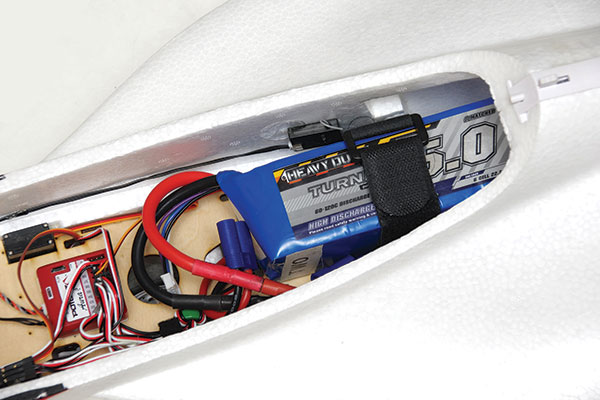










3 comments
Typo
You are 100% right! I missed
Wow, that little mistake
Add new comment